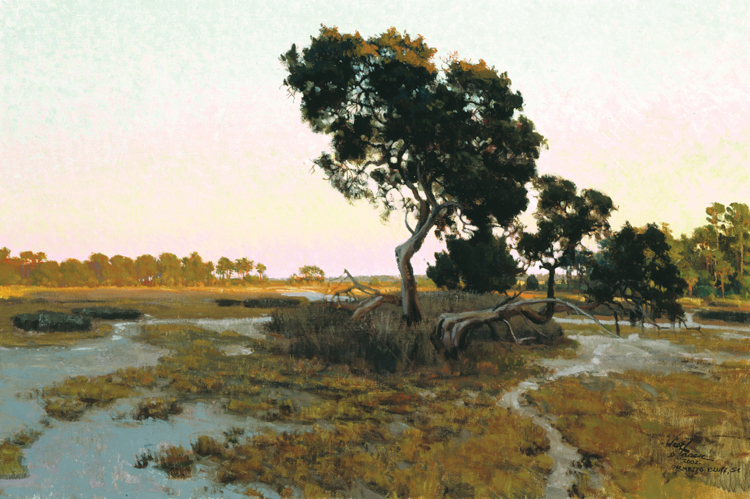Palmetto Bluff Real Estate Company Sales Office
Office Hours
Monday-Friday 9am - 5pm
Saturday 9am - 4pm
Sunday 12 - 4pm
Saturday 9am - 4pm
Sunday 12 - 4pm
Written by Lydia Moore, Palmetto Bluff Conservancy Research + Education Coordinator
The word “bat” often evokes horrific (and, in my opinion, over the top) images of Nosferatu and Dracula, sucking the lives out of innocent victims. We as a species have a tumultuous relationship with bats; some cultures fear them and others revere them.
When we discuss wildlife in the United States, bats are largely ignored until there is some sort of local or global health crisis. Rabies, Ebola, and coronaviruses can all be linked to bats, which become easy scapegoats since our culture fosters a negative stereotype of these elusive mammals. Everything about them seems “creepy” to us. The only parts of their vocalizations that are in the range of our hearing sound like clicks. They fly erratically, which is a jarring juxtaposition to the smooth flight of birds. They live in the sky at night – two realms that are completely foreign to us. We are not exposed to them and our lack of exposure make them appear abnormal and scary. In fact, bats have been used as the inspiration behind monsters in horror films.
Unsurprisingly, this fear is unwarranted. Let’s bust four common myths about bats.
All bats are vampires. Of the roughly 1,400 species of bat found worldwide, only three drink blood. The rest eat insects, fruit, nectar, fish, frogs, salamanders, rodents, birds, and even other bats! The only bats that drink blood are vampire bats (yes, vampire bats DO exist – and they look really cool). Of the three species of vampire bat – all of which are found in Central and South America, only one specializes in drinking the blood of mammals.
Vampire bats are SO unique! They have the ability to fly directly from the ground and to run, which most bats cannot do. Like all colonially roosting species, vampire bats are social. Unlike other bats, there are many studies of their altruistic behavior toward other vampire bats. A bat can easily starve if it comes back to the roost without securing a blood meal. If this happens, another bat in the colony will regurgitate part of its own meal to the hungry bat, allowing that bat to continue living while reducing its own probability of survival. Incredible!

All bats have rabies. While rabies is a seriously fatal virus, less than 1% of bats actually have it. Even so, 70% of rabies-related human deaths in the US can be traced to bats. What is the cause of this discrepancy? One factor could be that it is impossible to tell if a bat has rabies by observing its behavior. Unlike many other mammals, most rabid bats become lethargic instead of hostile and violent. When we see a bat on the ground, it may seem calm and unassuming, but it might not be doing very well. In fact, we rarely come into contact with healthy bats (they fly at night, remember?). Usually, the bat we encounter is a bat on the ground. Bats are vulnerable when they are on the ground and, even though there are benign reasons for it ending up in that predicament, assume that this bat is sick and too weak to fly. Check out this site to learn what to do if you find a grounded bat.

Bats are blind. Many people think bats are blind because most of them have itty bitty eyes and echolocate. But a bat’s eyes are adapted to being able to see in low light conditions. This means that bats have two modes of navigation – echolocation and vision – which they use under different circumstances. Echolocation is used for short-range navigation, keeping them from flying into trees and helping them find food. And vision? Vision is used for long-distance navigation, like following the edge of a forest, river corridor, or canyon rim. Bats can even see light in the ultraviolet spectrum – colors that we cannot see!

Bats get caught in your hair. This one made me literally laugh out loud when I first heard it. I was informed once that bats attack and get caught in human hair. For a bat to become stuck in your coiffure would mean they were oblivious to your presence. These incredible mammals can find and catch insects that are smaller than half an inch in length. Of course they can detect your presence!
Bats swoop and dive when foraging for insects. It looks like they are intentionally coming towards us when they do this – and they are! Just not for the reason you might think. Bats in South Carolina eat insects. Some insects that feed on us – like mosquitos – are attracted to carbon dioxide. We emit carbon dioxide every time we exhale, so to a mosquito carbon dioxide means food is nearby. Essentially, our emitted carbon dioxide attracts mosquitos and the mosquitos, in turn, attract bats. Those bats swooping down towards you? That’s a GOOD thing!
Let’s change our myths about bats from negative to positive. Stay tuned for next month’s post: Bats Schmats! Why should we care about bats?

Visionary land planner Mark Permar reflects on Palmetto Bluff's rich history and its enduring connection to the land. With Anson on the horizon, the legacy of designing with nature lives on.How did you first get involved with Palmetto Bluff? I believe it was ...

Explore Available Listings with Room For the Whole Family At Palmetto Bluff, life moves at the pace of the tides; slow enough to savor, yet rich with moments worth sharing. And when it comes to welcoming the people you love most, the right home makes all the ...

Real Estate in Bluffton, SC: Trends, Updates, and Insights The first half of 2025 has been nothing short of remarkable for Palmetto Bluff Real Estate Company, with sales volume, transaction count, and market share setting a strong pace for the year ahead. As ...

Enhancing Coastal Living With Lowcountry Landscaping Trends The Lowcountry lies along the southeastern coast of the United States, a region known for its breathtaking landscapes, rich history, and unique culture. From the charming streets of Charleston to the...

By Katie Epps, Palmetto Bluff Archaeologist Standing on the bluff that rises above the May River, gaze across the vast expanse of marsh and sky. This is a landscape virtually untouched by time. Imagine this vista in the eighteenth century, in the throes ...

The school year has officially begun, and the sound of school buses can be heard throughout the Lowcountry. As is true for much of South Carolina, Bluffton and the surrounding areas have experienced exceptional growth over the past 10 years, and so have the op...

As summer gives way to fall, Palmetto Bluff welcomes the season with a thoughtfully curated lineup of events that reflect the spirit of community and the beauty of the Lowcountry. For Club members, these gatherings are more than celebrations—they’re a signatur...

Tucked into the heart of the South Carolina Lowcountry, Palmetto Bluff is more than a destination—it’s a way of life. Spanning 20,000 acres of pristine marshes, winding rivers, and timeless Southern charm, the Bluff offers something for every type of traveler....

Tucked deep in the maritime forest and bordered by the headwaters of the May River, 11 Headwaters Road is one of the most private and secluded properties in Palmetto Bluff. Set on 24 acres within a gated enclave of just ten legacy estates, this seven-bedroom, ...

Two-Bedroom Homes in Palmetto Bluff: Small Spaces, Big Advantages At Palmetto Bluff, life moves at a more thoughtful pace, one centered around nature, community, and well-designed spaces that invite you to slow down and savor the moment. Within this disti...
Learn about the Palmetto Bluff Conservancy and how we keep the vision of our land in place.
On land or water, there is an ever-evolving variety of activities.
We do not attempt to independently verify the currency, completeness, accuracy or authenticity of the data contained herein. All area measurements and calculations are approximate and should be independently verified. Data may be subject to transcription and transmission errors. Accordingly, the data is provided on an “as is” “as available” basis only and may not reflect all real estate activity in the market”. © [2023] REsides, Inc. All rights reserved. Certain information contained herein is derived from information, which is the licensed property of, and copyrighted by, REsides, Inc.